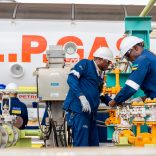Japan poised to sweeten offshore wind rules as players get cold feet
European economy and employment surge at fastest rate since 1995

European union flag against parliament in Brussels, Belgium. [Photo: Getty]
Eurozone employment and GDP grew at the fastest rate since records began in the third quarter of 2020.
Official data published by Eurostat on Tuesday showed employment and economic activity both grew at the fastest rate since 1995 when data began to be compiled.
Employment rebounded by 1% between August and October, defying expectations for a continued decline. Economists had been expecting employment to shrink by 2.8% in the quarter.
“While the impact of the COVID-19 pandemic on employment in persons was mitigated by government support schemes, the changes in hours worked were much more pronounced,” Eurostat said.
“Hours worked increased by 14.8% in the euro area and by 11.9% in the EU in the third quarter of 2020, compared with the previous quarter.”
Eurozone GDP grew by 12.5%, in-line with forecasts. The rebound was driven by surging consumer spending and a strong uptick in business investment as economies reopened following lockdowns earlier in the year.
The eurozone’s economic recovery in the third quarter outpaced the US, where GDP grew by 7.4% in the quarter, but was behind the UK, where activity jumped by 15.5%. This largely reflects the shallower initial economic slump in the US and the bigger slowdown in the UK.
France, Spain, and Italy were the best performing eurozone nations in the quarter. All three registered double digit GDP increases, partly due to sharper falls suffered earlier in the year.
Despite the strong bounce back, eurozone employment and economic activity remain below pre-pandemic levels. The bloc’s economy is still 4.4% smaller than it was at the end of 2019 and about as big as it was in 2017. Employment levels are 2.3% below last year’s levels, equating to 3.6m fewer people in work.
“A gap as bad as that seen in 2008 still remains, although we have to bear in mind that the economy was not completely open in the third quarter either,” said Bert Colijn, a senior eurozone economist at ING.
“Still, this explains why we don’t expect the economy to fully recover before 2022, as there is a lot of ground to regain.”
The second wave of COVID-19 has also swept across Europe since the end of the third quarter, suggesting the economy will go back into reverse in the final quarter of the year.
“Our baseline is that EZ GDP will fall by 3-to-4% quarter-on-quarter, but we need to see some hard data from the back-end of Q4 to get a clearer picture,” said Claus Vistesen, chief eurozone economist at Pantheon Macroeconomics.
By Oscar Williams-Grut
- ·Senior City Correspondent












Leave a Reply
Be the First to Comment!
You must be logged in to post a comment.
You must be logged in to post a comment.